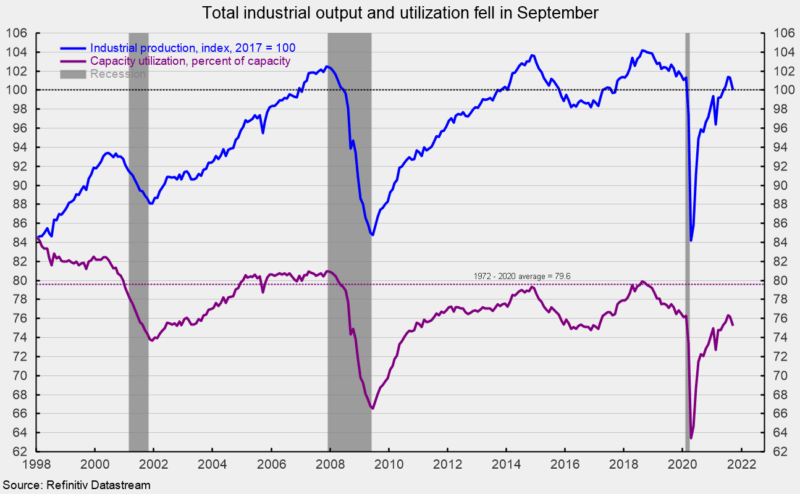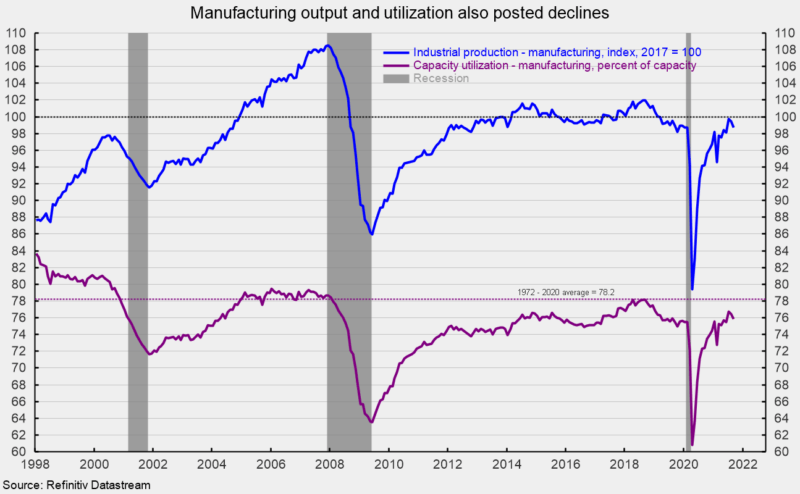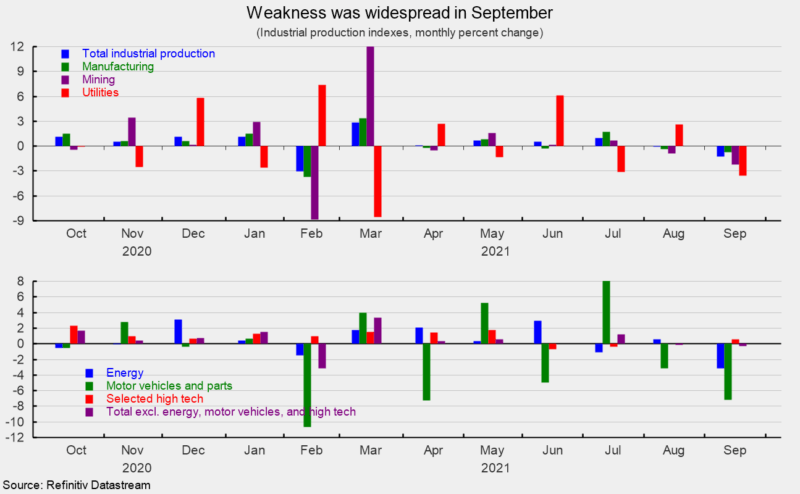Lingering Effects from Covid and Hurricane Ida Hurt Industrial Output in September
Industrial production fell 1.3 percent in September, the second decline in a row and the largest monthly drop since February. The decline pushed total output back below the February 2020 level (see first chart). Over the past year, total industrial output is still up 4.6 percent. Much of the decline was accounted for by the lingering effects of Covid which has been causing disruptions to manufacturing (especially motor vehicles production), and the effects of Hurricane Ida (about 0.6 percentage points of the 1.3 percent decline) which shut down significant portions of activity in the coastal region along the Gulf of Mexico, especially for the energy industry.
Capacity utilization fell a full percentage point to 75.2 percent from 76.2 percent in August and is below the February 2020 level of 76.3 percent. Total capacity utilization is also well below the long-term (1972 through 2020) average of 79.6 percent (see first chart).
Manufacturing output – about 76 percent of total output – posted a 0.7 percent decrease for the month, the second decline in a row and the fourth drop in the last seven months (see top of third chart). Manufacturing output is still above its February 2020 level (see second chart) and is up 4.8 percent from a year ago. Effects of Hurricane Ida accounted for about 0.3 percentage points of the 0.7 percent drop in manufacturing.
Manufacturing utilization fell 0.6 points to 75.9 percent but remains above the February 2020 level of 75.5 percent (see second chart). However, manufacturing utilization remains below its long-term average of 78.2 percent and well below the 1994-95 high of 84.7 percent.
Mining output accounts for about 12 percent of total industrial output and posted a sharp 2.3 percent decrease last month (see top of third chart). Over the last 12 months, mining output is up 6.9 percent. The lingering effects of Hurricane Ida more than accounted for the drop in mining activity.
Utility output, which is typically related to weather patterns and is also about 12 percent of total industrial output, decreased 3.6 percent for the month (see top of third chart). From a year ago, utility output is up 1.6 percent.
Among the key segments of industrial output, energy production (about 25 percent of total output) fell 3.1 percent for the month (see bottom of third chart) with declines in all five components. Total energy production is still up 4.8 percent from a year ago.
Motor-vehicle production (about 5 percent of total output), one of the hardest-hit industries during the lockdowns, continues to be volatile as the industry struggles with a semiconductor chip shortage. Motor-vehicle production sank 7.2 percent in September following a 3.2 percent drop in August and is down in five of the last eight months (see bottom of third chart). From a year ago, vehicle production is off 13.7 percent. Total vehicle assemblies fell to 8.60 million at a seasonally-adjusted annual rate. That consists of 8.33 million light vehicles and 0.27 million heavy trucks. Within light vehicles, light trucks were 7.18 million while cars were 1.41 million.
The selected high-tech industries index rose 0.6 percent in September (see bottom of third chart) and is up 10.7 percent versus a year ago. High-tech industries account for just 2.2 percent of total industrial output.
All other industries combined (total excluding energy, high-tech, and motor vehicles; about 68 percent of total industrial output) fell 0.2 percent in September (see bottom of third chart) but are 5.9 percent above September 2020.
Industrial output showed broad weakness in September, hurt by the lingering effects of Covid that has resulted in shortages of materials, and the lingering effects of Hurricane Ida that hit the energy industry particularly hard. While ongoing difficulties with labor, logistics, and materials shortages continue to be challenges for many industries especially in manufacturing, some of these issues may start to ease in the coming months and quarters, helping to reduce some of the upward pressure on prices.








